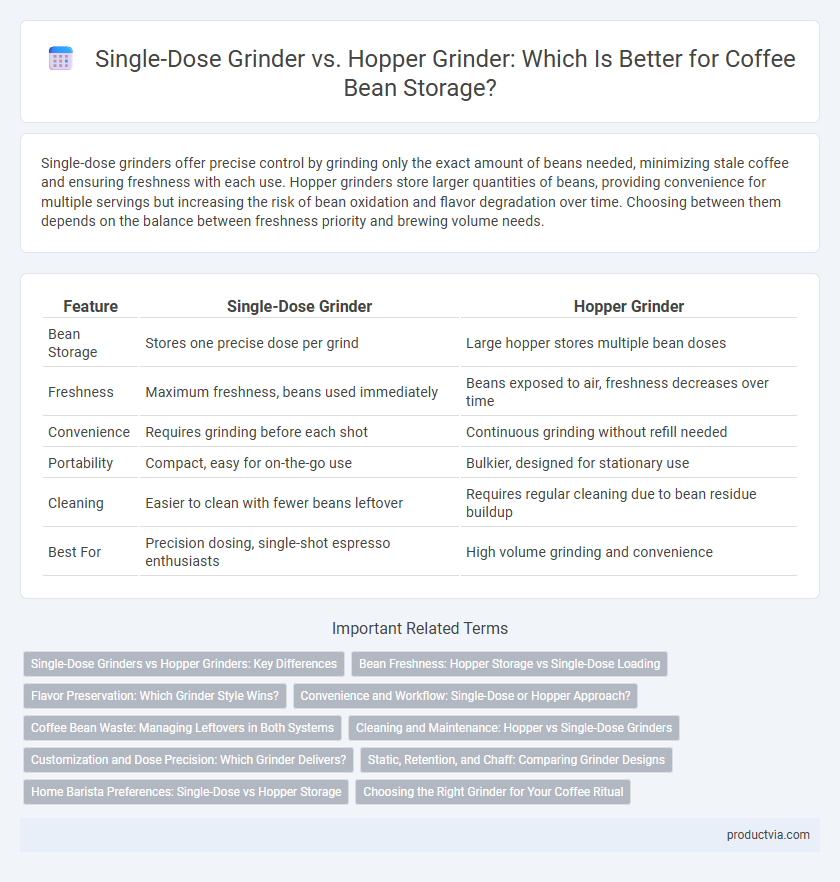Single-dose grinders offer precise control by grinding only the exact amount of beans needed, minimizing stale coffee and ensuring freshness with each use. Hopper grinders store larger quantities of beans, providing convenience for multiple servings but increasing the risk of bean oxidation and flavor degradation over time. Choosing between them depends on the balance between freshness priority and brewing volume needs.
Table of Comparison
| Feature | Single-Dose Grinder | Hopper Grinder |
|---|---|---|
| Bean Storage | Stores one precise dose per grind | Large hopper stores multiple bean doses |
| Freshness | Maximum freshness, beans used immediately | Beans exposed to air, freshness decreases over time |
| Convenience | Requires grinding before each shot | Continuous grinding without refill needed |
| Portability | Compact, easy for on-the-go use | Bulkier, designed for stationary use |
| Cleaning | Easier to clean with fewer beans leftover | Requires regular cleaning due to bean residue buildup |
| Best For | Precision dosing, single-shot espresso enthusiasts | High volume grinding and convenience |
Single-Dose Grinders vs Hopper Grinders: Key Differences
Single-dose grinders feature a chamber designed to hold only the exact amount of coffee beans needed for a single brew, ensuring maximum freshness by minimizing bean exposure to air and moisture. Hopper grinders contain a larger bean reservoir, typically holding several ounces, which allows for continuous grinding but can lead to faster staling due to prolonged bean storage. The choice between single-dose and hopper grinders depends on preferences for freshness control versus convenience in bean storage capacity.
Bean Freshness: Hopper Storage vs Single-Dose Loading
Single-dose grinders preserve bean freshness by grinding only the amount needed for each brew, eliminating exposure to air and moisture between uses. Hopper grinders store a larger quantity of beans, which can compromise freshness due to prolonged exposure to oxygen and environmental factors. Maintaining optimal bean freshness with hopper grinders requires airtight sealing and regular cleaning to minimize flavor degradation.
Flavor Preservation: Which Grinder Style Wins?
Single-dose grinders excel in flavor preservation by allowing users to grind only the exact amount of coffee needed, minimizing exposure to oxygen and preventing stale beans from affecting taste. Hopper grinders store larger quantities of beans, increasing the risk of flavor degradation over time due to prolonged air contact. For optimal freshness and consistent flavor, single-dose grinders are the preferred choice among coffee enthusiasts.
Convenience and Workflow: Single-Dose or Hopper Approach?
Single-dose grinders eliminate the need for bulk bean storage by allowing precise measurement of coffee beans per grind, enhancing convenience and reducing waste. Hopper grinders store larger quantities of beans, supporting continuous workflow and quick access but may compromise freshness due to extended bean exposure. Choosing between single-dose and hopper grinders depends on balancing bean freshness priorities with workflow efficiency and storage capacity.
Coffee Bean Waste: Managing Leftovers in Both Systems
Single-dose grinders minimize coffee bean waste by allowing precise measurement of beans for each brew, preventing leftover grounds from staling. Hopper grinders store larger quantities of beans, which can lead to increased waste if beans remain unused for extended periods and lose freshness. Implementing proper cleaning and storage practices in both systems reduces leftover residue and maintains optimal coffee quality.
Cleaning and Maintenance: Hopper vs Single-Dose Grinders
Single-dose grinders eliminate the risk of stale coffee by holding only one dose at a time, making cleaning straightforward with fewer components to maintain. Hopper grinders require regular cleaning to prevent oil buildup and stale beans, demanding more frequent attention to the hopper and burrs to preserve optimal flavor. Both require careful maintenance of burrs and dosing chambers, but single-dose grinders typically facilitate quicker, hassle-free cleaning sessions.
Customization and Dose Precision: Which Grinder Delivers?
Single-dose grinders offer precise grind customization by allowing users to weigh and grind a specific amount of beans for each brew, minimizing oxidation and preserving freshness. Hopper grinders, while convenient for storing larger quantities, can compromise dose precision due to bean aging and inconsistent grind distribution over time. For ultimate control over grind size and dose accuracy, single-dose grinders deliver superior performance tailored to individual brewing needs.
Static, Retention, and Chaff: Comparing Grinder Designs
Single-dose grinders minimize static and retention by grinding only the amount needed, reducing stale bean buildup and preventing chaff accumulation. Hopper grinders, while convenient for bulk storage, tend to retain more grounds and chaff due to larger bean reservoirs, increasing clogs and flavor degradation. The static generated in single-dose models is typically lower, resulting in cleaner dispensing and less waste compared to hopper designs.
Home Barista Preferences: Single-Dose vs Hopper Storage
Single-dose grinders offer precise control by grinding only the exact amount of beans needed, minimizing oxidation and preserving freshness, which appeals to home baristas valuing flavor clarity. Hopper grinders store larger quantities of beans, enabling quick access for multiple shots but potentially exposing beans to air and light, which may degrade quality over time. Home baristas often prefer single-dose grinders for small-scale brewing precision but choose hopper grinders for convenience during high-volume use.
Choosing the Right Grinder for Your Coffee Ritual
Single-dose grinders offer precise control over freshly ground coffee, minimizing bean oxidation and preserving flavor by grinding only the amount needed for each brew. Hopper grinders provide convenience for larger quantities, storing beans in bulk but increasing exposure to air, which can diminish freshness over time. Choosing the right grinder depends on your brewing frequency and emphasis on flavor preservation versus convenience in your coffee ritual.
Single-dose grinder vs Hopper grinder for bean storage Infographic

 productvia.com
productvia.com